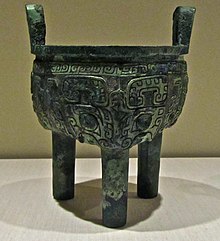Taotie




The Taotie ( Chinese 饕餮 , Pinyin tāotiè - " Wolverine , eater") is one of the most common decorative elements to be found on bronze vessels of the Shang and Zhou dynasties . The roots and precursors of this motif are much older and can be found on bronzes of the previous Erlitou culture and jades of the Liangzhu culture from sites in the lower Yangtze River Delta as well as their jade and turquoise plaques .
The term taotie
The term taotie is ahistorical. It can be found for the first time in written sources from the Warring States period and the Han Dynasty , where it is applied either to a voracious, mythological monster, to people who are associated with greed or gluttony, or to the decorative element of bronze art discussed here .
- Huainanzi , Chapter 15 / Role (instructions on military planning):
- 人 無 筋骨 之 強 , 爪牙 之 利 , 故 割 革 而 為 甲 , 鑠 鐵 而 為 刃。 貪 昧 昧 饕餮 之 人 , 殘 賊 天下 , 萬人 搔 動 , 莫寧 其所。
- People lack [great] strength in their tendons and bones, the sharpness of claws and teeth and that is why they tan leather and make shields from it and forge metal and make blades from it. Blind and greedy people damage and rob the world / the kingdom , tens of thousands of people are excited and restless and nobody likes to stay in their position.
- Lüshi Chunqiu , chapter 85 / role (knowledge of the preceding):
- 周 鼎 著 饕餮 , 有 首 無 身 , 食 人 未 咽 , 害 及其 身 身 以 以 言 報 更 也。
In fact, from the few written sources and since there are no contemporary sources about the motif from the Shang period, it is unclear how the Shang themselves called the decor or whether it is related to mythological wolverine taotie . However, this can be assumed, since some bronze vessels explicitly show two animals - mostly dragons or tigers - in profile, facing each other and opening their mouths. Examples with human faces or entire figures between the animals are also known. There are also bronze vessels that show big cats, whose wide-open mouth surrounds a huddled person. It can therefore be assumed that the motif of eating found expression in an abstract form as a taotie decor. The decor is therefore also interpreted as a metaphor for a transition between this world and the hereafter. This theory is supported by the use of ritual bronzes in ancestral cult and the numerous human sacrifices documented by archaeological excavations.
The figure of the taotie
The central component of the taotie motif is a pair of eyes that are arranged around a central axis. All other components are optional and can be more or less pronounced depending on the individual example or development phase of the motif. In general, it can be said that the design of the motif becomes more complex over time and reached its peak in the Zhou period. However, it is not the case that stages or lines of development can be determined in every case. Later taotie can also be kept minimalist and simple. The following labeled example shows a typical taotie with the most common elements:
literature
- Elizabeth Childs-Johnson: The Ghost Head Mask and Metamorphic Shang Imagery. In: Early China. Edited by the Society for the Study of Early China (Berkeley), Volume 20, 1995, pp. 79-92.
- Roger Goepper (ed.): The old China. People and gods in the Middle Kingdom 5000 BC - AD 220 (exhibition catalog Kulturstiftung Ruhr Essen, Villa Hügel, June 2, 1995 - November 5, 1995 = Gudai-Zhongguo-wenwu-zhan). Hirmer, Munich 1995.
- Ladislav Kesner: The Taotie Reconsidered. Meanings and Functions of the Shang Theriomorphic Imagery. In: Artibus Asiae. Ed. 51 / 1.2, Museum Rietberg: Zürich (1991), pp. 29–53.
